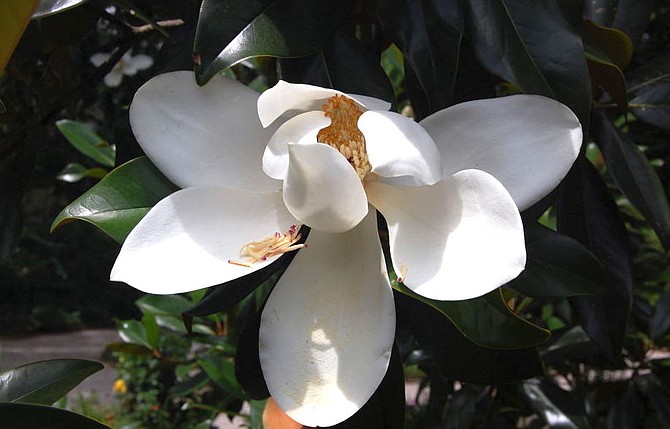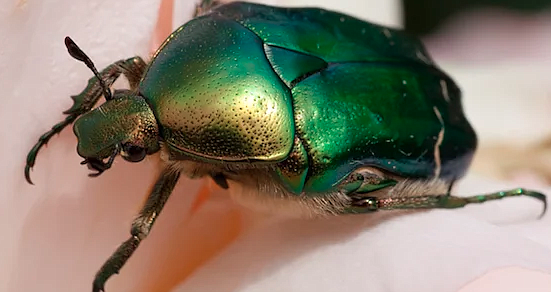 Facebook
Facebook
 X
X
 Instagram
Instagram
 TikTok
TikTok
 Youtube
Youtube

Magnolia, the Southern U.S. native commonly planted as a decorative street tree in many of San Diego’s older neighborhoods, continues to bloom this month. Called the “queen of the flowering broadleaf evergreens,” its branches support leathery, dark-green leaves and large, white blossoms of pleasing fragrance.

June Bugs are emerging as summer’s warmth is finally upon us. The green June beetle, only one of some 300 species of scarab beetles found in Southern California, flashes a metallic green underbelly as it buzzes about erratically. The mature scarabs flying about have spent at least a year underground in larval form munching at the roots of lawns or your favorite ornamental plants.
The full moon rises in twilight about a half hour after sunset (8pm) on June 24 and for the next week. After dark, you’ll see that it’s in the edge of the Sagittarius Teapot — if you can see the Teapot’s 2nd and 3rd-magnitude stars through the moonlight! Binoculars help. Remember, the Teapot (12° wide) way overspills a binocular’s field of view (typically 6° or 8° or so).
Mars is passing through the heart of the Beehive Star Cluster, M44, this evening for North America. Get your binoculars or low-power, wide-field telescope on Mars, very low in the west-northwest, right at the end of dusk. (Faint Mars is about a fist at arm’s length to the upper left of bright Venus.) At the time of dusk at other longitudes around the world, Mars will be more toward one edge of the cluster.
Leo the Lion is mostly a constellation of late winter and spring. But he’s not gone yet. As twilight ends, look due west, somewhat low, for Regulus, his brightest and now lowest star: the forefoot of the Lion stick figure. The Sickle of Leo extends to the upper right from Regulus.
The above comes from the Outdoors listings in the Reader compiled by Jerry Schad, author of Afoot & Afield in San Diego County. Schad died in 2011. Planet information from SkyandTelescope.org.


Magnolia, the Southern U.S. native commonly planted as a decorative street tree in many of San Diego’s older neighborhoods, continues to bloom this month. Called the “queen of the flowering broadleaf evergreens,” its branches support leathery, dark-green leaves and large, white blossoms of pleasing fragrance.

June Bugs are emerging as summer’s warmth is finally upon us. The green June beetle, only one of some 300 species of scarab beetles found in Southern California, flashes a metallic green underbelly as it buzzes about erratically. The mature scarabs flying about have spent at least a year underground in larval form munching at the roots of lawns or your favorite ornamental plants.
The full moon rises in twilight about a half hour after sunset (8pm) on June 24 and for the next week. After dark, you’ll see that it’s in the edge of the Sagittarius Teapot — if you can see the Teapot’s 2nd and 3rd-magnitude stars through the moonlight! Binoculars help. Remember, the Teapot (12° wide) way overspills a binocular’s field of view (typically 6° or 8° or so).
Mars is passing through the heart of the Beehive Star Cluster, M44, this evening for North America. Get your binoculars or low-power, wide-field telescope on Mars, very low in the west-northwest, right at the end of dusk. (Faint Mars is about a fist at arm’s length to the upper left of bright Venus.) At the time of dusk at other longitudes around the world, Mars will be more toward one edge of the cluster.
Leo the Lion is mostly a constellation of late winter and spring. But he’s not gone yet. As twilight ends, look due west, somewhat low, for Regulus, his brightest and now lowest star: the forefoot of the Lion stick figure. The Sickle of Leo extends to the upper right from Regulus.
The above comes from the Outdoors listings in the Reader compiled by Jerry Schad, author of Afoot & Afield in San Diego County. Schad died in 2011. Planet information from SkyandTelescope.org.
Comments